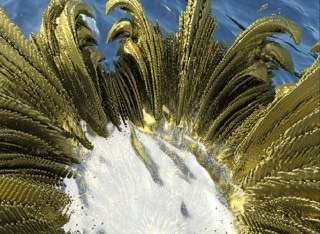Aug 29 2017
Hydrogen gas is a vital synthetic feedstock that is set to contribute considerably in renewable energy technology. While this is true, its capabilities are underplayed because most of this gas is presently being sourced from fossil fuels, for example natural gas.
Now, a more sustainable approach to hydrogen fuel production has been discovered by a KAUST team who used chaotic, light-trapping materials that imitate the natural mechanism of photosynthetic water splitting.
 A nanostructured metamaterial with a sunflower-like arrangement can be immersed in water to generate hydrogen gas with superb efficiency. (© 2017 WILEY-VCH Verlag GmbH & Co.)
A nanostructured metamaterial with a sunflower-like arrangement can be immersed in water to generate hydrogen gas with superb efficiency. (© 2017 WILEY-VCH Verlag GmbH & Co.)
Since it is impractical to manufacture the complex enzymes present within the plants, researchers have developed a special kind of photocatalysts that use high-energy, hot electrons to split water molecules into oxygen and hydrogen gas. Of late, nanostructured metals that transform solar electrons into powerful, wave-like plasmon resonances have triggered a great deal of interest for hydrogen production. With the help of the high-speed metal plasmons, carriers can be transferred to catalytic sites before they slow down and lower catalytic efficiency.
It is difficult to make metal nanoparticles react to the whole broadband spectrum of visible light.
Plasmonic systems have specific geometries that trap light only at characteristic frequencies. Some approaches try to combine multiple nanostructures to soak up more colors, but these absorptions take place at different spatial locations so the sun’s energy is not harvested very efficiently.
Andrea Fratalocchi, who headed the research.
A new strategy was devised by Fratalocchi and his team using metal nanostructures called epsilon-near-zero (ENZ) metamaterials, which grow with arbitrary, fractal needles just like a small pine tree. Within the cavities developed by the protruding metal branches, the propagation of light almost comes to a standstill allowing the ENZ substance to squeeze the entire visible light colors to the same nanometer-scale sites.
Yet, optimizing the ENZ metamaterial for the generation of hydrogen gas was shown to be a prolonged process that can take several months. Also, not every needle-like structure functions in the same manner, and therefore the researchers have to adjust all fabrication parameters to identify the right disorder for efficient reactions. In addition, if semiconducting titanium dioxide is selected as a substrate to gather hot electrons, then crystals with very high purity will be required. Lastly, the position and concentration of platinum nanoparticles that are used to catalytically cleave the water molecules had to be accurately controlled, but such depositions are difficult to achieve because of the complex geometry of the ENZ material.
The result was worth the effort: experiments showed that broadband light is used by the ENZ photocatalyst to produce hot carriers inside a narrow 10-nm interfacial region for an overall efficiency gain of 300%.
Due to the possibility of controlling their absorption, the ENZ nanostructures are ideal candidates for solar-energy harvesting. We recently engineered an industrial prototype with impressive efficiency, which makes us very optimistic about the future possibilities of this technology.
Fratalocchi.